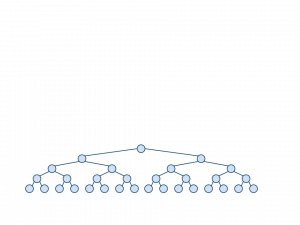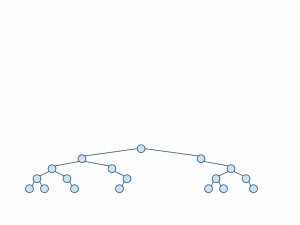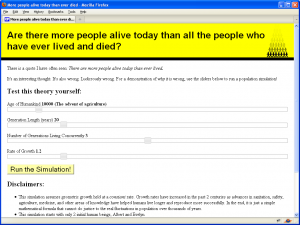A few years ago, I ran across this quote:
“There are more people alive today than have ever died.”
As we contemplate overpopulation, a quote like that is quite thought-provoking and shocking. Could it be that the living today outnumber all of our ancestors? It’s astounding. However, I didn’t believe it. I still don’t believe it, and for good reason.
For one thing, relatively trusted sources say otherwise:
- Recount Your Dead (Snopes.com)
- Worst 10 Urban Myths (Myth #3 on Null Hypothesis)
- Fact or Fiction: Living People Outnumber the Dead (Scientific American)
Where did the myth come from?
Good question. I’m guessing it came from a college sophomore studying computer science. If you look at doubling, you’ll notice that each successive result is larger, by 1, than the sum of all previous results:
1, 2, 4, 8, 16, 32, 64 ... n^2
If you look at a perfect binary tree, the relationship to population becomes more apparent:

“Assume a Spherical Sheep”
There’s a joke I’m fond of that involves a physicist describing to a farmer how he can get more wool from his sheep. “First,” he says, “assume a spherical sheep.” We often turn to simplified models to help explain complex phenomena, but in the case of the sheep and in the case of human population growth, the model makes quite a few assumptions that just don’t reflect reality. The main assumption made when using a perfect binary tree as a model is that population doubles with each successive generation. But what if that isn’t the case?

Now the last generation is outnumbered by its predecessors! This could be due to disease, war, infant mortality, hungry tigers, or any number of things. World population actually decreased during the Black Death of the 14th century, so the population growth rate was, for a time, negative.
You might say, and quite rightly, that more than just one generation is alive at a given time. Your parents are probably alive. Your grandparents may be alive. You may have children. That’s why I decided to build a population simulator!

Use the sliders (thanks, jQuery!) to adjust some of the variables, such as the age of humankind, the number of years between generations, and the growth rate. If you hope to produce a result in line with the Earth’s current human population (about 7 billion), you will find that population growth has been, on average, extremely slow over the course of human history. It’s a rough world out there: not everyone lives (or, at very least, not long enough to reproduce).
You might also object that, even if population growth has been slow historically, we haven’t had a devastating plague lately–couldn’t a few recent successive generations of dramatic growth easily surpass prior generations?

Not really. The above representation only shows 27 generations–maybe 600-700 years. In reality, the long thin line of ancestors on the left vastly outnumbers the dramatic growth on the right.
Check out the infographic in the June 2011 issue of National Geographic, which estimates that 7 billion are alive today, while 108 billion have previously lived (extrapolated from Carl Haub’s 1975 estimates).